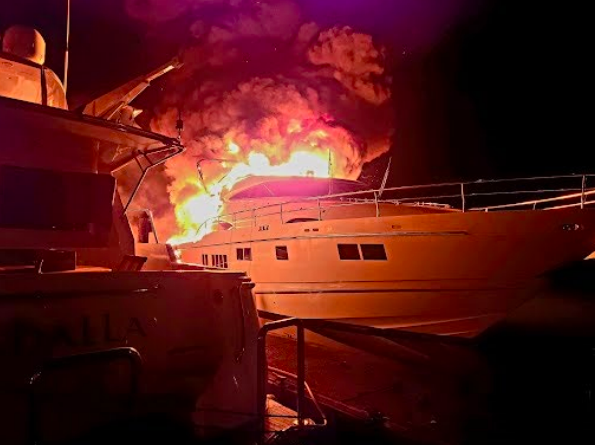Oily rags destroyed yacht worth $1.5m

America’s National Transportation Safety Board (NTSB) has highlighted the fire hazards of improperly stored oily rags on vessels, following an investigation into a fire aboard a yacht on 15 July, 2022, in Washington.
The 2012 Fairline Pegasus caught fire while moored at the Peninsula Yacht Basin in Gig Harbor. The fire burned for about an hour before it was reported. By the time firefighters arrived, the fire had engulfed the aft section of the yacht. Pegasus, valued at about $1.5m, was declared a total loss. No injuries were reported.
During the investigation, Pegasus‘ owner told the NTSB that he believed the likely cause of the fire was fireworks that landed on the vessel. But, the marina’s security camera footage showed no activity around the yacht before the smoke and flames were captured.
In the video, the fire burned for about 45 minutes before intensifying and spreading forward. At 3.02am, a bystander noticed the fire and called 911. Gig Harbor Police officers arrived at the marina at 3.16am, followed four minutes later by firefighting units.
The police officers found the aft half of the Pegasus completely engulfed in flames, with the fire threatening a vessel moored nearby. Firefighters laid out fire hose from a shore plug to the end of the long pier and docks. The hose was charged, and firefighting efforts commenced at 3.32am from the floating docks on the starboard side of the Pegasus. Nine minutes later, a firefighting boat arrived and started fighting the blaze from the opposite side of the vessel. A second fire hose was rigged from shore and charged, with water on the fire at 3.42am.
Firefighters knocked down the flames, says the NTSB report, but the fire was persistent and continued to flare up. At 4.14am, the stern of the Pegasus sank with the bow rising out of the water. The bow then slowly settled as the vessel continued to take on water. The last of the fire was extinguished at 4.31am, when the main deck cabin was inundated with seawater.
NTSB determined the fire aboard the Pegasus was caused by spontaneous combustion due to the self-heating of used oil-soaked rags that had been improperly disposed of. The day before the fire a bag with rags soaked with a raw-linseed-oil product was left under a table on the aft deck.
“Rags soaked with oil-based finishes, which are commonly used for painting and refinishing, pose a fire hazard if stored improperly,” NTSB’s report says. “Because they generate heat as they dry, oily rags that are piled up, put together in a trash can, or bagged do not allow the heat to escape, creating a high risk for spontaneous combustion.”
The vessel owner and his employee told investigators that, on the day before the fire, they had been refinishing wood surfaces of the vessel using a name-brand teak oil finish. The teak oil was applied to the surfaces with a brush, and excess oil was wiped off using microfibre towels. The employee stated that, after completing the work, he wrapped the used towels in new towels, placed them in a plastic bag, and left the bag under the wood table on the aft deck of the yacht. He and the owner then left the vessel between 4pm and 5pm that same evening.
The oil finish used by the owner and employee was sold in metal cans with a warning which included the words: Teak oil may spontaneously catch fire if improperly discarded. The label also contained directions to place rags in a sealed, water-filled metal container.
The product contained raw linseed oil, a substance known to be a risk for self-heating and spontaneous combustion when soaked in rags.
Self-heating is a process in which heat is created within a material through a biological or chemical process and without the application of an external heat source, says the NTSB. If self-heating increases the temperature of the material above its ignition point with sufficient oxygen present, self-ignition can occur. Sufficient air must be present to sustain the combustion reaction, but not so much air that the heat is dissipated.
The oils commonly used in oil-based paints and stains release heat as they dry. If the heat is not released in the air, it builds up. That is why a pile of oily rags can be dangerous. As the rags dry, the heat is trapped. The heat builds up and finally causes a fire.
The fire marshal classified the cause of the fire as accidental.
Earlier this month, three people were confirmed to have died as a fire engulfed a dive boat in Egypt.










